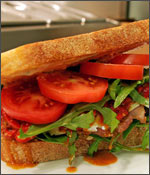|
|
| Help | |
| You are here: Rediff Home » India » Cricket » IPL » Report |
|
 | ||
| |||||||||||||||||||||||
|
| |||||||||||||||||||||||
Everyone is climbing onto the 'diet foods' bandwagon these days -- wholewheat bread, oatmeal and fat-free dressings are to be found on most kitchen shelves and people are spending huge sums of money in the name of health.
If you're planning on stocking up on health foods too, or are already in the process of doing so, here are some little-known facts about those available in the Indian market:
If you are a calorie-conscious person and plan to become or stay slim, you need not spend large sums of money on diet foods. You can eat healthy without overspending and here's how:
While normal sliced white bread costs between Rs 12 and Rs 15 per packet, brown bread can cost anywhere between Rs 25 and Rs 40. So read the label to see if the brown bread is actually whole-grain or made with at least 75 percent whole wheat flour and only then invest in it. Also, eating a slice or two of white bread in a day is not really such a big deal even if you are on a diet, provided you are eating sufficient whole grain foods throughout the rest of the day.
Moreover, a can of a diet cola costs about Rs 25, while a natural and much healthier option like coconut water costs only Rs 15 and comes with a side-benefit -- it's great for your skin! You can also up your dose of Vitamin C and refresh yourself with a glass of freshly-squeezed lime juice for just Rs 5. So replace those colas in your refrigerator with natural drinks that are cheaper and healthier and don't forget the cheapest and best drink of them all -- water.
If you want to make a low-cal sandwich spread, tie up a large bowl of curds in a piece of cheese muslin cloth and leave it to hang overnight (or for two hours minimum) with a dish underneath. Once the whey has drained into the dish, add a little garlic, salt and pepper -- it will make an excellent low-calorie sandwich spread. If you refrigerate it, you can use the spread for at least 2 days.The cost? Rs 5.
A better, cheaper option? The ice-candy sticks available locally, each of which contain only about 40 calories and cost Rs 5 to Rs 10 each.
In conclusion, if something really is making a difference to your health, it's okay to spend a little bit extra on it -- tetrapack milk, for instance, is less adulterated and more hygienic than what you buy from the local milkman. But weigh your options carefully before spending your hard-earned money on foods that don't make a dramatic difference to your calorie intake and still cost a lot more than regular products.
Samreedhi Goel is a certified personal trainer and nutritionist. She runs her own training studio, Size Wise, and conducts fitness workshops.
Photograph: Scott Barbour/Getty Images
|
|
| © 2008 Rediff.com India Limited. All Rights Reserved. Disclaimer | Feedback |